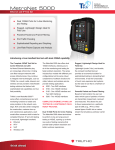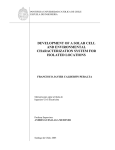Download SFP Transceivers User Manual
Transcript
GE Security SFP Transceivers User Manual P/N 1069181 • REV 1.0 • ISS 22FEB10 Copyright © 2010 GE Security, Inc. This document may not be copied in whole or in part or otherwise reproduced without prior written consent from GE Security, Inc., except where specifically permitted under US and international copyright law. Disclaimer The information in this document is subject to change without notice. GE Security, Inc. (“GE Security”) assumes no responsibility for inaccuracies or omissions and specifically disclaims any liabilities, losses, or risks, personal or otherwise, incurred as a consequence, directly or indirectly, of the use or application of any of the contents of this document. For the latest documentation, contact your local supplier or visit us online at www.gesecurity.com. This publication may contain examples of screen captures and reports used in daily operations. Examples may include fictitious names of individuals and companies. Any similarity to names and addresses of actual businesses or persons is entirely coincidental. Trademarks and patents Intended use FCC compliance GE and the GE monogram are trademarks of General Electric Company. Other trade names used in this document may be trademarks or registered trademarks of the manufacturers or vendors of the respective products. Use this product only for the purpose it was designed for; refer to the data sheet and user documentation for details. For the latest product information, contact your local supplier or visit us online at www.gesecurity.com. This equipment has been tested and found to comply with the limits for a Class B digital device, pursuant to part 15 of the FCC Rules. These limits are designed to provide reasonable protection against harmful interference in a residential installation. This equipment generates, uses and can radiate radio frequency energy and, if not installed and used in accordance with the instructions, may cause harmful interference to radio communications. However, there is no guarantee that interference will not occur in a particular installation. If this equipment does cause harmful interference to radio or television reception, which can be determined by turning the equipment off and on, the user is encouraged to try to correct the interference by one or more of the following measures: • Reorient or relocate the receiving antenna. • Increase the separation between the equipment and receiver. • Connect the equipment into an outlet on a circuit different from that to which the receiver is connected. • Consult the dealer or an experienced radio/TV technician for help. Regulatory information Manufacturer N4131 GE Security, Inc. HQ and regulatory responsibility: GE Security, Inc., 8985 Town Center Parkway, Bradenton, FL 34202, USA EU authorized manufacturing representative: GE Security B.V., Kelvinstraat 7, 6003 DH Weert, The Netherlands 2002/96/EC (WEEE directive): Products marked with this symbol cannot be disposed of as unsorted municipal waste in the European Union. For proper recycling, return this product to your local supplier upon the purchase of equivalent new equipment, or dispose of it at designated collection points. For more information see: www.recyclethis.info. Contact information For contact information see our Web site: www.gesecurity.com. For contact information see our Web site: www.gesecurity.eu. Content Chapter 1 Overview 1 Model List 2 Checklist 2 Introduction 2 Installing SFP modules 3 Appendix A Fiber Optic Cable Parameters 7 SFP Transceivers User Manual i Chapter 1 Overview The GE Security SFP1000 and SFP100 family of Small Form Factor Pluggable (SFP, also known as mini-GBIC) Transceiver Modules is specifically designed for a high performance integrated duplex data link over single mode optical fiber. These transceiver modules are compliant with the SFP Multisource Agreement (MSA). With the hot plug ability, these modules offer an easy way to be installed into SFP MSA compliant ports at any time without the interruption of the host equipments operating online. The SFP Transceivers can be installed into any of GE Security Switch products with the 100Base-FX or 1000Base-SX/LX SFP interface. SFP Transceivers User Manual 1 Chapter 1: Overview Model List The GE SFP1000/SFP100 Transceiver family comes with one of the following models. SFP module List Model SFP1000SX-220 SFP1000LX-10Km Interface Speed Fiber connector and distance 1000Base-SX 1000Mbps LC, Multi-Mode (850nm) -220m/550m 1000Base-LX 1000Mbps LC, Single Mode (1310nm) – 10km SFP100FX1310-TSC-2Km 100Base-FX 100Mbps LC, Multi-Mode (1310nm) -2km SFP100FX1310-TSC-20Km 100Base-FX 100Mbps LC, Single Mode (1310nm) – 20km Checklist Your SFP Transceiver box should contain the following items: • The SFP transceiver module • This User's manual If any item is missing or damaged, please consult the dealer from whom you purchased you SFP Transceiver module. Introduction 1000Base-SX / LX SFP Mini-GBIC Modules - SFP1000SX-220, SFP1000LX10Km Features: 2 • Complies with the IEEE 802.3z Gigabit Ethernet standard • 1 X 1000Mbps fiber port SFP Transceivers User Manual Chapter 1: Overview • Plug and Play Installation • SFP1000SX-220 provides distance up to 220m over 62.5/125µm fiber cable and 550m over 50/125µm fiber cable • SFP1000LX-10Km provides distance up to 10km over 9/125µm single mode fiber cable 100Base-FX SFP Mini-GBIC Modules - SFP100FX1310-TSC-2Km / SFP100FX1310-TSC-20Km Features: • Complies with IEEE 802.3u Fast Ethernet standard • 1 x 100Mbps fiber port • Plug and Play Installation • SFP100FX1310-TSC-2Km provides distance up to 2km over 62.5/125µm multi-mode fiber cable • SFP100FX1310-TSC-20Km provides distance up to 20km over 9/125µm single mode fiber cable Installing SFP modules The section describes how to insert an SFP transceiver into an SFP slot. The SFP transceivers are hot pluggable and hot swappable. You can plug-in and out the transceiver from any SFP port without having to power down the Switch/Media Converter. As Figure 1 shows. SFP Transceivers User Manual 3 Chapter 1: Overview Figure 1: Plug-in the SFP transceiver Note: Before connecting the other switches, workstations or Media Converters ensure the following conditions are met. 1. Make sure both sides of the SFP transceiver are the same media type, for example: 100Base-FX to 100Base-FX, 1000Base-SX to 1000Base-SX. 2. Check that the fiber-optic cable type matches the SFP transceiver model. • To connect to a SFP1000SX-220m or a SFP100FX1310-TSC2Km SFP transceiver, use the multi-mode fiber cable- where one side must be a male duplex LC connector type. • To connect to the SFP1000LX-10km or the SFP100FX1310TSC-20Km SFP transceiver, use the single-mode fiber cablewhere one side must be a male duplex LC connector type. Connecting the Fiber cable 4 1. Attach the duplex LC connector on the network cable into the SFP transceiver. 2. Connect the other end of the cable to a device - switches with SFP installed, fiber NIC on a workstation or a Media Converter. SFP Transceivers User Manual Chapter 1: Overview 3. Check that the LNK/ACT LED on the SFP slot of the switch/converter. Ensure that the SFP transceiver is operating correctly. 4. Check the Link mode of the SFP port. If the link failed. Set the Link mode to "1000 Force" or "100 Force" if needed. Removing the module 1. Make sure that there is no network activity by checking with the network administrator. Or through the management interface of the switch/converter (if available) to disable the port in advance. 2. Remove the Fiber Optic Cable gently. 3. Turn the handle of the MFB module to horizontal. 4. Pull out the module gently through the handle. Figure 2: Pullout the transceiver Note: Never pull out the module without pull the handle or the push bolts on the module. Pulling out the module with too much force could damage the module and SFP module slot of the Managed Industrial Switch. SFP Transceivers User Manual 5 Chapter 1: Overview 6 SFP Transceivers User Manual Appendix A Fiber Optic Cable Parameters The wiring details are shown below: Standard Fiber Type Cable Specification 1000Base-SX (850nm) Multi-mode 50/125 μm or 62.5/125μm 1000Base-LX (1310nm) Single mode 9/125μm Multi-mode 50/125μm or 62.5/125μm Single mode 9/125μm 100Base-FX (1310nm) SFP Transceivers User Manual 7






















